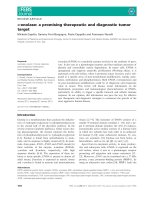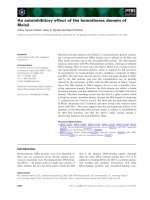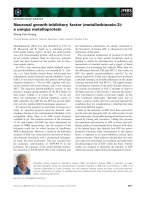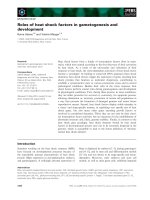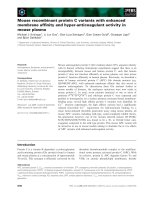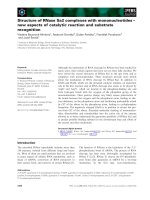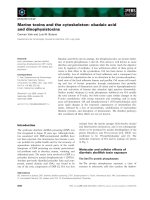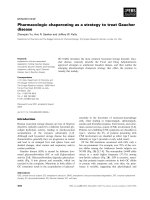Tài liệu Báo cáo khoa học: "Improving Chinese Semantic Role Labeling with Rich Syntactic Features" ppt
Bạn đang xem bản rút gọn của tài liệu. Xem và tải ngay bản đầy đủ của tài liệu tại đây (303 KB, 5 trang )
Proceedings of the ACL 2010 Conference Short Papers, pages 168–172,
Uppsala, Sweden, 11-16 July 2010.
c
2010 Association for Computational Linguistics
Improving Chinese Semantic Role Labeling with Rich Syntactic Features
Weiwei Sun
∗
Department of Computational Linguistics, Saarland University
German Research Center for Artificial Intelligence (DFKI)
D-66123, Saarbr
¨
ucken, Germany
Abstract
Developing features has been shown cru-
cial to advancing the state-of-the-art in Se-
mantic Role Labeling (SRL). To improve
Chinese SRL, we propose a set of ad-
ditional features, some of which are de-
signed to better capture structural infor-
mation. Our system achieves 93.49 F-
measure, a significant improvement over
the best reported performance 92.0. We
are further concerned with the effect
of parsing in Chinese SRL. We empiri-
cally analyze the two-fold effect, grouping
words into constituents and providing syn-
tactic information. We also give some pre-
liminary linguistic explanations.
1 Introduction
Previous work on Chinese Semantic Role La-
beling (SRL) mainly focused on how to imple-
ment SRL methods which are successful on En-
glish. Similar to English, parsing is a standard
pre-processing for Chinese SRL. Many features
are extracted to represent constituents in the input
parses (Sun and Jurafsky, 2004; Xue, 2008; Ding
and Chang, 2008). By using these features, se-
mantic classifiers are trained to predict whether a
constituent fills a semantic role. Developing fea-
tures that capture the right kind of information en-
coded in the input parses has been shown crucial
to advancing the state-of-the-art. Though there
has been some work on feature design in Chinese
SRL, information encoded in the syntactic trees is
not fully exploited and requires more research ef-
fort. In this paper, we propose a set of additional
∗
The work was partially completed while this author was
at Peking University.
features, some of which are designed to better cap-
ture structural information of sub-trees in a given
parse. With help of these new features, our sys-
tem achieves 93.49 F-measure with hand-crafted
parses. Comparison with the best reported results,
92.0 (Xue, 2008), shows that these features yield a
significant improvement of the state-of-the-art.
We further analyze the effect of syntactic pars-
ing in Chinese SRL. The main effect of parsing
in SRL is two-fold. First, grouping words into
constituents, parsing helps to find argument candi-
dates. Second, parsers provide semantic classifiers
plenty of syntactic information, not to only recog-
nize arguments from all candidate constituents but
also to classify their detailed semantic types. We
empirically analyze each effect in turn. We also
give some preliminary linguistic explanations for
the phenomena.
2 Chinese SRL
The Chinese PropBank (CPB) is a semantic anno-
tation for the syntactic trees of the Chinese Tree-
Bank (CTB). The arguments of a predicate are la-
beled with a contiguous sequence of integers, in
the form of AN (N is a natural number); the ad-
juncts are annotated as such with the label AM
followed by a secondary tag that represents the se-
mantic classification of the adjunct. The assign-
ment of semantic roles is illustrated in Figure 1,
where the predicate is the verb “调查/investigate”.
E.g., the NP “事故原因/the cause of the accident”
is labeled as A1, meaning that it is the Patient.
In previous research, SRL methods that are suc-
cessful on English are adopted to resolve Chinese
SRL (Sun and Jurafsky, 2004; Xue, 2008; Ding
and Chang, 2008, 2009; Sun et al., 2009; Sun,
2010). Xue (2008) produced complete and sys-
tematic research on full parsing based methods.
168
IP
b
b
b
b
b
b
b
b
b
b
b
b
b
b
b
b
b
b
b
b
b
b
b
b
b
b
b
b
b
b
b
b
b
A0 VP
d
d
d
d
d
d
d
d
d
d
d
d
d
d
d
d
d
d
d
d
d
d
i
i
i
i
i
i
i
i
i
i
i
i
NP AM-TMP AM-MNR VP
Z
Z
Z
Z
Z
Z
Z
Z
Z
Z
Z
Z
Z
Z
Z
Z
Z
Z
Z
Z
Z
Z
NN ADVP ADVP Rel A1
警方
police
AD AD VV NP
i
i
i
i
i
i
i
i
i
i
i
i
正在
now
详细
thoroughly
调查
investigate
NN NN
事故
accident
原因
cause
Figure 1: An example sentence: The police are
thoroughly investigating the cause of the accident.
Their method divided SRL into three sub-tasks: 1)
pruning with a heuristic rule, 2) Argument Identi-
fication (AI) to recognize arguments, and 3) Se-
mantic Role Classification (SRC) to predict se-
mantic types. The main two sub-tasks, AI and
SRC, are formulated as two classification prob-
lems. Ding and Chang (2008) divided SRC into
two sub-tasks in sequence: Each argument should
first be determined whether it is a core argument or
an adjunct, and then be classified into fine-grained
categories. However, delicately designed features
are more important and our experiments suggest
that by using rich features, a better SRC solver
can be directly trained without using hierarchical
architecture. There are also some attempts at re-
laxing the necessity of using full syntactic parses,
and semantic chunking methods have been intro-
duced by (Sun et al., 2009; Sun, 2010; Ding and
Chang, 2009).
2.1 Our System
We implement a three-stage (i.e. pruning, AI and
SRC) SRL system. In the pruning step, our sys-
tem keeps all constituents (except punctuations)
that c-command
1
current predicate in focus as ar-
gument candidates. In the AI step, a lot of syntac-
tic features are extracted to distinguish argument
and non-argument. In other words, a binary classi-
fier is trained to classify each argument candidate
as either an argument or not. Finally, a multi-class
classifier is trained to label each argument recog-
nized in the former stage with a specific semantic
role label. In both AI and SRC, the main job is to
select strong syntactic features.
1
See (Sun et al., 2008) for detailed definition.
3 Features
A majority of features used in our system are a
combination of features described in (Xue, 2008;
Ding and Chang, 2008) as well as the word for-
mation and coarse frame features introduced in
(Sun et al., 2009), the c-command thread fea-
tures proposed in (Sun et al., 2008). We give
a brief description of features used in previous
work, but explain new features in details. For
more information, readers can refer to relevant
papers and our source codes
2
that are well com-
mented. To conveniently illustrate, we denote
a candidate constituent c
k
with a fixed context
w
i−1
[
c
k
w
i
w
h
w
j
]w
j+1
, where w
h
is the head
word of c
k
, and denote predicate in focus with
a context w
v
−2
w
v
−1
w
v
w
v
+1
w
v
+2
, where w
v
is the
predicate in focus.
3.1 Baseline Features
The following features are introduced in previous
Chinese SRL systems. We use them as baseline.
Word content of w
v
, w
h
, w
i
, w
j
and w
i
+w
j
;
POS tag of w
v
, w
h
. subcategorization frame, verb
class of w
v
; position, phrase type c
k
, path from c
k
to w
v
(from (Xue, 2008; Ding and Chang, 2008))
First character, last character and word length
of w
v
, first character+length, last character+word
length, first character+position, last charac-
ter+position, coarse frame, frame+w
v
, frame+left
character, frame+verb class, frame+c
k
(from (Sun
et al., 2009)).
Head word POS, head word of PP phrases, cat-
egory of c
k
’s lift and right siblings, CFG rewrite
rule that expands c
k
and c
k
’s parent (from (Ding
and Chang, 2008)).
3.2 New Word Features
We introduce some new features which can be
extracted without syntactic structure. We denote
them as word features. They include:
Word content of w
v
−1
, w
v
+1
, w
i−1
and w
j+1
;
POS tag of w
v
−1
, w
v
+1
, w
v
−2
, w
v
+2
, w
i−1
, w
i
, w
j
,
w
j+1
, w
i+2
and w
j−2
.
Length of c
k
: how many words are there in c
k
.
Word before “LC”: If the POS of w
j
is “LC”
(localizer), we use w
j−1
and its POS tag as two
new features.
NT: Does c
k
contain a word with POS “NT”
(temporal noun)?
2
Available at />csrler/.
169
Combination features: w
i
’s POS+w
j
’s POS,
w
v
+Position
3.3 New Syntactic Features
Taking complex syntax trees as inputs, the clas-
sifiers should characterize their structural proper-
ties. We put forward a number of new features to
encode the structural information.
Category of c
k
’s parent; head word and POS of
head word of parent, left sibling and right sibling
of c
k
.
Lexicalized Rewrite rules: Conjuction of
rewrite rule and head word of its corresponding
RHS. These features of candidate (lrw-c) and its
parent (lrw-p) are used. For example, this lrw-
c feature of the NP “事 故原因” in Figure 1 is
NP → NN + NN(原因).
Partial Path: Path from the c
k
or w
v
to the low-
est common ancestor of c
k
and w
v
. One path fea-
ture, hence, is divided into left path and right path.
Clustered Path: We use the manually created
clusters (see (Sun and Sui, 2009)) of categories of
all nodes in the path (cpath) and right path.
C-commander thread between c
k
and w
v
(cct):
(proposed by (Sun et al., 2008)). For example, this
feature of the NP “警方” in Figure 1 is N P +
ADV P + ADV P + V V .
Head Trace: The sequential container of the
head down upon the phrase (from (Sun and Sui,
2009)). We design two kinds of traces (htr-p, htr-
w): one uses POS of the head word; the other uses
the head word word itself. E.g., the head word of
事故原因 is “原因” therefore these feature of this
NP are NP↓NN and NP↓原因.
Combination features: verb class+c
k
, w
h
+w
v
,
w
h
+Position, w
h
+w
v
+Position, path+w
v
,
w
h
+right path, w
v
+left path, frame+w
v
+w
h
,
and w
v
+cct.
4 Experiments and Analysis
4.1 Experimental Setting
To facilitate comparison with previous work, we
use CPB 1.0 and CTB 5.0, the same data set-
ting with (Xue, 2008). The data is divided into
three parts: files from 081 to 899 are used as
training set; files from 041 to 080 as develop-
ment set; files from 001 to 040, and 900 to 931
as test set. Nearly all previous research on con-
stituency based SRL evaluation use this setting,
also including (Ding and Chang, 2008, 2009; Sun
et al., 2009; Sun, 2010). All parsing and SRL ex-
periments use this data setting. To resolve clas-
sification problems, we use a linear SVM classi-
fier SVM
lin
3
, along with One-Vs-All approach for
multi-class classification. To evaluate SRL with
automatic parsing, we use a state-of-the-art parser,
Bikel parser
4
(Bikel, 2004). We use gold segmen-
tation and POS as input to the Bikel parser and
use it parsing results as input to our SRL system.
The overall LP/LR/F performance of Bikel parser
is 79.98%/82.95%/81.43.
4.2 Overall Performance
Table 1 summarizes precision, recall and F-
measure of AI, SRC and the whole task (AI+SRC)
of our system respectively. The forth line is
the best published SRC performance reported in
(Ding and Chang, 2008), and the sixth line is the
best SRL performance reported in (Xue, 2008).
Other lines show the performance of our system.
These results indicate a significant improvement
over previous systems due to the new features.
Test P(%) R(%) F/A
AI 98.56 97.91 98.24
SRC - - - - 95.04
(Ding and Chang, 2008) - - - - 94.68
AI + SRC 93.80 93.18 93.49
(Xue, 2008) 93.0 91.0 92.0
Table 1: SRL performance on the test data with
gold standard parses.
4.3 Two-fold Effect of Parsing in SRL
The effect of parsing in SRL is two-fold. On the
one hand, SRL systems should group words as ar-
gument candidates, which are also constituents in
a given sentence. Full parsing provides bound-
ary information of all constituents. As arguments
should c-command the predicate, a full parser can
further prune a majority of useless constituents. In
other words, parsing can effectively supply SRL
with argument candidates. Unfortunately, it is
very hard to rightly produce full parses for Chi-
nese text. On the other hand, given a constituent,
SRL systems should identify whether it is an argu-
ment and further predict detailed semantic types if
3
/>˜
vikass/svmlin.html
4
/>˜
dbikel/
software.html
170
Task Parser Bracket Feat P(%) R(%) F/A
AI - - Gold W 82.44 86.78 84.55
CTB Gold W+S 98.69 98.11 98.40
Bikel Bikel W+S 77.54 71.62 74.46
SRC - - Gold W - - - - 93.93
CTB Gold W+S - - - - 95.80
Bikel Gold W+S - - - - 92.62
Table 2: Classification perfromance on develop-
ment data. In the Feat column, W means word
features; W+S means word and syntactic feautres.
it is an argument. For the two classification prob-
lems, parsing can provide complex syntactic infor-
mation such as path features.
4.3.1 The Effect of Parsing in AI
In AI, full parsing is very important for both
grouping words and classification. Table 2 sum-
marizes relative experimental results. Line 2 is the
AI performance when gold candidate boundaries
and word features are used; Line 3 is the perfor-
mance with additional syntactic features. Line 4
shows the performance by using automatic parses
generated by Bikel parser. We can see that: 1)
word features only cannot train good classifiers to
identify arguments; 2) it is very easy to recognize
arguments with good enough syntactic parses; 3)
there is a severe performance decline when auto-
matic parses are used. The third observation is a
similar conclusion in English SRL. However this
problem in Chinese is much more serious due to
the state-of-the-art of Chinese parsing.
Information theoretic criteria are popular cri-
teria in variable selection (Guyon and Elisse-
eff, 2003). This paper uses empirical mutual
information between each variable and the tar-
get, I(X, Y ) =
x∈X,y∈Y
p(x, y) log
p(x,y)
p(x)p(y)
, to
roughly rank the importance of features. Table 3
shows the ten most useful features in AI. We can
see that the most important features all based on
full parsing information. Nine of these top 10 use-
ful features are our new features.
Rank Feature Rank Feature
1 w
v
cct 2
‡
w
h
+w
v
+Position
3 htr-w 4 htr-p
5 path 6
‡
w
h
+w
v
7 cpath 8 cct
9 path+w
v
10 lrw-p
Table 3: Top 10 useful features for AI. ‡ means
word features.
4.3.2 The Effect of Parsing in SRC
The second block in Table 2 summarizes the SRC
performance with gold argument boundaries. Line
5 is the accuracy when word features are used;
Line 6 is the accuracy when additional syntactic
features are added; The last row is the accuracy
when syntactic features used are extracted from
automatic parses (Bikel+Gold). We can see that
different from AI, word features only can train
reasonable good semantic classifiers. The com-
parison between Line 5 and 7 suggests that with
parsing errors, automatic parsed syntactic features
cause noise to the semantic role classifiers.
4.4 Why Word Features Are Effective for
SRC?
Rank Feature Rank Feature
1
‡
frame+w
h
+w
v
2
‡
w
h
+w
v
+position
3
‡
w
h
+w
v
4 w
v
+cct
5 lrw-p 6
†
w
i
+w
j
7 lrw-c 8
‡
w
h
+Postion
9
†
frame+w
v
10 htr-p
Table 4: Top 10 useful features for SRC.
Table 4 shows the ten most useful features in
SRC. We can see that two of these ten features
are word features (denoted by †). Namely, word
features play a more important role in SRC than
in AI. Though the other eight features are based
on full parsing, four of them (denoted by ‡) use
the head word which can be well approximated
by word features, according to some language spe-
cific properties. The head rules described in (Sun
and Jurafsky, 2004) are very popular in Chinese
parsing research, such as in (Duan et al., 2007;
Zhang and Clark, 2008). From these head rules,
we can see that head words of most phrases in
Chinese are located at the first or the last position.
We implement these rules on Chinese Tree Bank
and find that 84.12%
5
nodes realize their heads as
either their first or last word. Head position sug-
gests that boundary words are good approximation
of head word features. If head words have good
approximation word features, then it is not strange
that the four features denoted by ‡ can be effec-
tively represented by word features. Similar with
feature effect in AI, most of most useful features
in SRC are our new features.
5
This statistics excludes all empty categories in CTB.
171
5 Conclusion
This paper proposes an additional set of features
to improve Chinese SRL. These new features yield
a significant improvement over the best published
performance. We further analyze the effect of
parsing in Chinese SRL, and linguistically explain
some phenomena. We found that (1) full syntactic
information playes an essential role only in AI and
that (2) due to the head word position distribution,
SRC is easy to resolve in Chinese SRL.
Acknowledgments
The author is funded both by German Academic
Exchange Service (DAAD) and German Research
Center for Artificial Intelligence (DFKI).
The author would like to thank the anonymous
reviewers for their helpful comments.
References
Daniel M. Bikel. 2004. A distributional analysis
of a lexicalized statistical parsing model. In
Dekang Lin and Dekai Wu, editors, Proceed-
ings of EMNLP 2004, pages 182–189. Associa-
tion for Computational Linguistics, Barcelona,
Spain.
Weiwei Ding and Baobao Chang. 2008. Improv-
ing Chinese semantic role classification with hi-
erarchical feature selection strategy. In Pro-
ceedings of the EMNLP 2008, pages 324–
333. Association for Computational Linguis-
tics, Honolulu, Hawaii.
Weiwei Ding and Baobao Chang. 2009. Fast se-
mantic role labeling for Chinese based on se-
mantic chunking. In ICCPOL ’09: Proceed-
ings of the 22nd International Conference on
Computer Processing of Oriental Languages.
Language Technology for the Knowledge-
based Economy, pages 79–90. Springer-Verlag,
Berlin, Heidelberg.
Xiangyu Duan, Jun Zhao, and Bo Xu. 2007.
Probabilistic models for action-based Chinese
dependency parsing. In ECML ’07: Pro-
ceedings of the 18th European conference on
Machine Learning, pages 559–566. Springer-
Verlag, Berlin, Heidelberg.
Isabelle Guyon and Andr
´
e Elisseeff. 2003. An
introduction to variable and feature selec-
tion. Journal of Machine Learning Research,
3:1157–1182.
Honglin Sun and Daniel Jurafsky. 2004. Shallow
semantc parsing of Chinese. In Daniel Marcu
Susan Dumais and Salim Roukos, editors, HLT-
NAACL 2004: Main Proceedings.
Weiwei Sun. 2010. Semantics-driven shallow
parsing for Chinese semantic role labeling. In
Proceedings of the ACL 2010.
Weiwei Sun and Zhifang Sui. 2009. Chinese func-
tion tag labeling. In Proceedings of the 23rd
Pacific Asia Conference on Language, Informa-
tion and Computation. Hong Kong.
Weiwei Sun, Zhifang Sui, and Haifeng Wang.
2008. Prediction of maximal projection for se-
mantic role labeling. In Proceedings of the
22nd International Conference on Computa-
tional Linguistics.
Weiwei Sun, Zhifang Sui, Meng Wang, and Xin
Wang. 2009. Chinese semantic role labeling
with shallow parsing. In Proceedings of the
2009 Conference on Empirical Methods in Nat-
ural Language Processing, pages 1475–1483.
Association for Computational Linguistics, Sin-
gapore.
Nianwen Xue. 2008. Labeling Chinese predi-
cates with semantic roles. Comput. Linguist.,
34(2):225–255.
Yue Zhang and Stephen Clark. 2008. A tale of two
parsers: Investigating and combining graph-
based and transition-based dependency parsing.
In Proceedings of the 2008 Conference on Em-
pirical Methods in Natural Language Process-
ing, pages 562–571. Association for Computa-
tional Linguistics, Honolulu, Hawaii.
172
